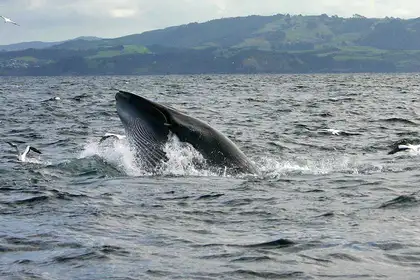
A Bryde’s whale feeding in the Hauraki Gulf [Credit: Gabriela Tezanos-Pinto].
Research into the long-term survival and abundance of the Hauraki Gulf’s Bryde’s whale population has used photographs of their fins to aid efforts in improving the management of the small population.
Bryde’s whales (Balaenoptera edeni) are classified as nationally critical in New Zealand and appear only on the north-eastern coast of the North Island. In the Hauraki Gulf, Bryde’s whales appear year-round usually in waters deeper than 40 meters.
The study, led by Massey University’s Dr Gabriela Tezanos-Pinto, collated an extensive database of photographs showing distinctive fin features of individual whales over eight years to obtain missing demographic information about the local population.
The study catalogued 72 whales over 8 years, of which, 20 returned to the Gulf year after year. Overall, the study estimated that less than 50 whales visit the Gulf each season.
“Our analysis indicates that the local population of Bryde’s whales could not sustain the death of more than one whale per year. This highlights the fragility of the local population, particularly, when we know that ship strikes have been previously estimated to cause an average mortality of 2 whales per year in the Gulf”.
Adjunct researcher of the Coastal-Marine Research Group, Dr Tezanos-Pinto says “Before the study, detailed demographic information of this population was unknown.While we cannot yet make assumptions about the trajectory of the local population over time, our results can now provide baseline information that can be used to monitor trends in the future and improve the management of the local population”.
Using photo identification allows us to focus on the individual whales, whereas other studies are focusing on aerial observation, which provides valuable information on distribution, habitat use, and other important areas, but cannot detect changes in individual preferences, i.e. whether the same whales are returning or if new ones are immigrating to the gulf.
“Our results show that there is a combination of some whales returning, whereas others do not, but new immigrants are coming in as well”.
“The data could be used in the future to examine population trajectories over time and the impact of ship strikes on the long-term persistence of the population, but our findings highlight the need for continuous, as opposed to intermittent, photo-identification studies of Bryde’s whales so that fluctuations in abundance, movements, female reproductive rates, individual patterns of residency and habitat use can be monitored over time.”
This is the first study looking into the long-term site fidelity and estimates of apparent survival for Bryde’s whales in the Hauraki Gulf using photo identification methods.
This research was funded by the Hauraki Gulf Research Fund administered by the Department of Conservation and Auckland Whale and Dolphin Safaris (former Dolphin Explorer).
The article ‘Local abundance, apparent survival and site fidelity of Bryde’s whales in the Hauraki Gulf (New Zealand) inferred from long-term photo identification appeared in the journal, Endangered Species Research.